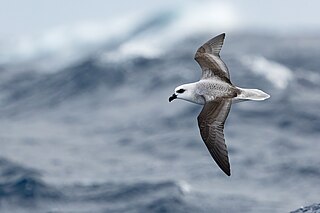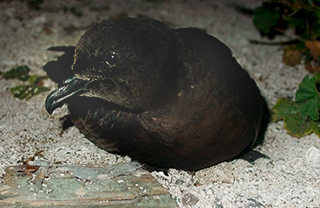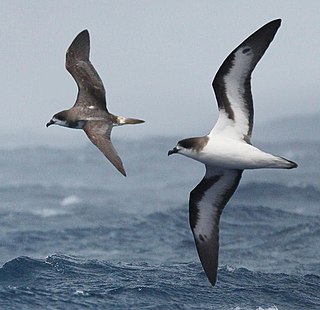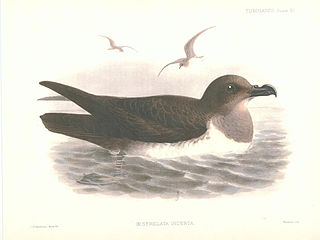
The gadfly petrels or Pterodroma are a genus of about 35 species of petrels, part of the seabird order Procellariiformes. The gadfly petrels are named for their speedy weaving flight, as if evading gadflies (horseflies). The flight action is also reflected in the name Pterodroma, from Ancient Greek pteron, "wing" and dromos, "runner".

The Fea's petrel is a small seabird in the gadfly petrel genus, Pterodroma. It was previously considered to be a subspecies of the soft-plumaged petrel, but they are actually not closely related at all. However, P. feae is very closely related to Zino's petrel and Desertas petrel, two other species recently split from P. mollis. The gadfly petrels are named for their speedy weaving flight, as if evading horseflies. The flight action is also reflected in the genus name Pterodroma, from Ancient Greek pteron, "wing" and dromos, " runner". This species is named after the Italian zoologist Leonardo Fea (1852-1903).

Zino's petrel or the freira, is a species of small seabird in the gadfly petrel genus, endemic to the island of Madeira. This long-winged petrel has a grey back and wings, with a dark "W" marking across the wings, and a grey upper tail. The undersides of the wings are blackish apart from a triangle of white at the front edge near the body, and the belly is white with grey flanks. It is very similar in appearance to the slightly larger Fea's petrel, and separating these two Macaronesian species at sea is very challenging. It was formerly considered to be a subspecies of the soft-plumaged petrel, P. mollis, but they are not closely related, and Zino's was raised to the status of a species because of differences in morphology, calls, breeding behaviour and mitochondrial DNA. It is Europe's most endangered seabird, with breeding areas restricted to a few ledges high in the central mountains of Madeira.

The black-capped petrel, also known as the diablotín, is a small seabird native to the West Indies in the genus Pterodroma. It is a long-winged petrel with a grey-brown back and wings, with a white nape and rump. Underparts are mainly white apart from a black cap and some dark underwing markings. It picks food items such as squid from the ocean surface.

Bulweria is a genus of seabirds in the family Procellariidae named after English naturalist James Bulwer. The genus has two extant species, Bulwer's petrel and Jouanin's petrel. A third species, the Olson's petrel, became extinct in the early 16th century; it is known only from skeletal remains. Bulwer's petrel ranges in the Atlantic, Indian and Pacific Oceans, whereas Joaunin's petrel is confined to the northwestern Indian Ocean. Olson's petrel is known from the Atlantic.

The Bermuda petrel is a gadfly petrel. Commonly known in Bermuda as the cahow, a name derived from its eerie cries, this nocturnal ground-nesting seabird is the national bird of Bermuda and can be found pictured on Bermudian currency. The Bermuda petrel is the second rarest seabird on the planet. They have medium-sized body and long wings, a greyish-black crown and collar, dark grey upper-wings and tail, white upper-tail coverts and white under-wings edged with black, and the underparts are completely white.

The Atlantic petrel is a gadfly petrel endemic to the South Atlantic Ocean. It breeds in enormous colonies on Tristan da Cunha and Gough Island, and ranges at sea from Brazil to Namibia, with most records at sea being to the west of the breeding islands, and along the subtropical convergence. Adults are about 43 cm long, powerful, large, stocky, dark in color with white belly. Their head can appear to be grey in worn plumage. Brown undercoating of wings and tail. These petrels can live on average of 15 years of age.

Pseudobulweria is a genus of seabirds in the family Procellariidae. They have long been retained with the gadfly petrel genus Pterodroma despite morphological differences. Mitochondrial DNA cytochrome b sequence analysis has confirmed the split out of Pterodroma and places the genus closer to shearwaters. They thus represent either a plesiomorphic lineage still sharing some traits of the ancestral Procellariidae with the gadfly petrels, or convergent evolution of a shearwater to the ecological niche of gadfly petrels.
Saint Helena, Ascension Island and Tristan da Cunha, as well the other uninhabited islands nearby, are a haven for wildlife in the middle of the Atlantic Ocean. The islands are or were home to much endemic flora and fauna, especially invertebrates, and many endemic fish species are found in the reef ecosystems off the islands. The islands have been identified by BirdLife International as Important Bird Areas for both their endemic landbirds and breeding seabirds.

The soft-plumaged petrel is a species of seabird in the family Procellariidae.
The Saint Helena shearwater is an extinct species of seabird in the petrel family. It is known only from subfossil remains found on the island of Saint Helena in the South Atlantic Ocean. It probably became extinct at the end of the last glacial period, or the early Holocene, as the climate became warmer.
Michael John Imber was a New Zealand ornithologist known for his research work and expertise on petrels.
The Oʻahu petrel is an extinct species of very small gadfly petrel known only from subfossil material found in the Hawaiian Islands. The specific epithet comes from the Latin jugabilis, meaning “that which may be joined”, with reference to the unusual, nearly conjoined, supraorbital salt gland depressions on the cranium. It has no obvious close relatives among living species of Pterodroma.
Imber's petrel is an extinct seabird of gadfly petrel from the Chatham Islands. The species' epithet commemorates New Zealand ornithologist Mike Imber (1940–2011).
This page is based on this
Wikipedia article Text is available under the
CC BY-SA 4.0 license; additional terms may apply.
Images, videos and audio are available under their respective licenses.









